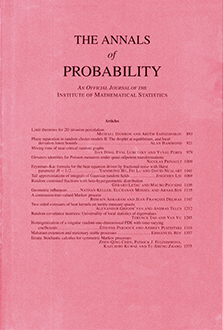Abstract
Let ({Xi(t)}i∈ℤd)t≥0 be the system of interacting diffusions on [0, ∞) defined by the following collection of coupled stochastic differential equations: $$dX_{i}(t)=\sum\limits_{j\in \mathbb{Z}^{d}}a(i,j)[X_{j}(t)-X_{i}(t)]\,dt+\sqrt{bX_{i}(t)^{2}}\ dW_{i}(t),\quad i\in \mathbb{Z}^{d},\ t\geq 0.$$ Here, a(⋅, ⋅) is an irreducible random walk transition kernel on ℤd×ℤd, b∈(0, ∞) is a diffusion parameter, and ({Wi(t)}i∈ℤd)t≥0 is a collection of independent standard Brownian motions on ℝ. The initial condition is chosen such that {Xi(0)}i∈ℤd is a shift-invariant and shift-ergodic random field on [0, ∞) with mean Θ∈(0, ∞) (the evolution preserves the mean).
We show that the long-time behavior of this system is the result of a delicate interplay between a(⋅, ⋅) and b, in contrast to systems where the diffusion function is subquadratic. In particular, let â(i, j)=½[a(i, j)+a(j, i)], i, j∈ℤd, denote the symmetrized transition kernel. We show that:
(A) If â(⋅, ⋅) is recurrent, then for any b>0 the system locally dies out.
(B) If â(⋅, ⋅) is transient, then there exist b*≥b2>0 such that:
(B1) The system converges to an equilibrium νΘ (with mean Θ) if 0<b<b*.
(B2) The system locally dies out if b>b*.
(B3) νΘ has a finite 2nd moment if and only if 0<b<b2.
(B4) The 2nd moment diverges exponentially fast if and only if b>b2.
The equilibrium νΘ is shown to be associated and mixing for all 0<b<b*. We argue in favor of the conjecture that b*>b2. We further conjecture that the system locally dies out at b=b*.
For the case where a(⋅, ⋅) is symmetric and transient we further show that:
(C) There exists a sequence b2≥b3≥b4≥⋯>0 such that:
(C1) νΘ has a finite mth moment if and only if 0<b<bm.
(C2) The mth moment diverges exponentially fast if and only if b>bm.
(C3) b2≤(m−1)bm<2.
(C4) lim m→∞(m−1)bm=c=sup m≥2(m−1)bm.
The proof of these results is based on self-duality and on a representation formula through which the moments of the components are related to exponential moments of the collision local time of random walks. Via large deviation theory, the latter lead to variational expressions for b* and the bm’s, from which sharp bounds are deduced. The critical value b* arises from a stochastic representation of the Palm distribution of the system.
The special case where a(⋅, ⋅) is simple random walk is commonly referred to as the parabolic Anderson model with Brownian noise. This case was studied in the memoir by Carmona and Molchanov [Parabolic Anderson Problem and Intermittency (1994) Amer. Math. Soc., Providence, RI], where part of our results were already established.
Citation
A. Greven. F. den Hollander. "Phase transitions for the long-time behavior of interacting diffusions." Ann. Probab. 35 (4) 1250 - 1306, July 2007. https://doi.org/10.1214/009117906000001060
Information





